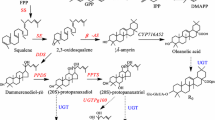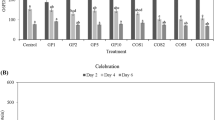Abstract
β-Glucosidase and β-galactosidase activity profile tested in different seeds during 24 h germination revealed reasonably high levels of activity inVigna radiata, Cicer arietinum, andTrigonella foenum-graecum. In all seeds tested, β-galactosidase activity was, in general, higher than that of β-glucosidase.T. foenum-graecum seedlings exhibited maximal total and specific activities for both the enzymes during 72 h germination. Se supplementation as Na2SeO3 up to 0.75 ppm was found to be beneficial to growth and revealed selective enhancement of β-galactosidase activity by 40% at 0.5 ppm Se. The activities of both the enzymes drastically decreased at 1.0 ppm level of Se supplementation. On the contrary, addition of Na2SeO3 in vitro up to 1 ppm to the enzyme extracts did not influence these activities. Hydrolytic rates of β-glucosidase in both control and Se-supplemented groups were enhanced by 20% with 0.05M glycerol in the medium and 30% at 0.1M glycerol. The rates were marginally higher in Se-supplemented seedlings than the controls, irrespective of added glycerol in the medium. In contrast, hydrolysis by β-galactosidase showed a trend of decrease in Se-supplemented seedlings compared to the control, when glycerol was present in the medium. Addition of Se in vitro in the assay medium showed no difference in the hydrolytic rate by β-galactosidase when compared to control, while the activity of β-glucosidase declined by 50%. Se-grown seedlings showed an enhancement of transglucosidation rate by 40% in the presence of 0.1M glycerol. The study reveals a differential response to Se among the β-galactosidase and β-glucosidase ofT. foenumgraecum with increase in the levels of β-galactosidase activity.
Similar content being viewed by others
References
R. F. Burk and K. E. Hill, Regulation of selenoproteins,Ann. Rev. Nutr. 13, 65–81 (1993).
T. C. Stadman, Selenium biochemistry,Ann. Rev. Biochem. 59, 111–127 (1990).
J. T. Rotruck, A. L. Pope, H. E. Ganther, A. B. Swanson, D. G. Hafeman, and W. G. Hockstra, Selenium: Biochemical role as a component of glutathione peroxidase,Science,179, 588–590 (1973).
O. Epp, R. Ladenstein and A. Wendel, The refined structure of seleno enzyme glutathione peroxidase at 0.2 nm resolution,Eur. J. Biochem. 133(1), 51–69 (1983).
O. A. Levander, D. P. DeLoach, V. C. Morris, and P. B. Moser, Platelet glutathione peroxidase activity as an index of Se status in rats,J. Nutr. 113, 55–63 (1983).
V. Narayanaswamy, R. Padma Bai, M. Babu, and K. Lalitha, Selenium mediated biochemical changes in Japanese quails: Formulation of semi-purified low selenium diet and effect on glutathione peroxidase,Biol. Trace. Elem. Res. 10(2), 79–89 (1986).
P. D. Whanger, P. H. Weswig, J. A. Schmitz, and J. E. Oldfied, Effect of selenium and vitamin E on blood Se levels, tissue glutathione peroxidase activities and white muscle disease in sheep fed purified or hay diets,J. Nutr. 107, 1298–1307 (1977).
A. Wendel and R. Otter, Alterations in the intermediary metabolism of selenium deficient mice,Biochim. Biophys. Acta. 925, 94–100 (1987).
T. C. Stadman, Some selenium dependent biochemical process,Adv. Enzymol. 48, 1–28 (1979).
G. N. Schrauzer, D. A. White, and C. J. Schneider, Selenium and Cancer: Effect selenium and of the diet on the genesis of spontaneous mammary tumors in virgin inbred female C3H/St mice,Bioinorganic Chem. 8(5), 387–396 (1978).
G. N. Scharuzer, Selenium and Cancer: A review,Bioinorganic Chem. 5(3), 275–281 (1976).
J. Smith and A. Shrift, Phylogenetic distribution of GSH Px,Comp. Biochem. Physiol. 63B, 39–44 (1979).
A. Shrift, Aspects of selenium metabolism in higher plants,Ann. Rev. Plant Physiol. 20, 475–494 (1969).
P. M. Dey and E. D. Campillo, Biochemistry of the multiple forms of glycosidases in plants,Adv. Enzymol. 56, 141–249 (1984).
B. Henrissat, A classification of glycosyl hydrolases based on amino acid sequence similarities,Biochem. J. 280, 309–316 (1991).
H. M. Flowers and N. Sharon, Glycosidases-Properties and application to the study of complex carbohydrates,Adv. Enzymol. 48, 29–95 (1979).
R. Leah, J. Kigel, I. Svendsen, and J. Mundy, Biochemical and molecular characterisation of a barley seed β-glucosidase,J. Biol. Chem. 270(26), 15789–15795 (1995).
K. Lalitha and K. Easwari, Kinetic analysis Selenium -75 uptake by mitochondria of different Se status,Biol. Trace. Elem. Res. 48(1), 67–90 (1995).
W. D. Bonner. Jr, Preparation of plant mitochondria,Meth. Enzymol. 10, 126–133 (1967).
J. P. Weber and A. L. Fink, Temperature dependent change in the rate limiting step of β-glucosidase catalysis,J. Biol. Chem. 255(19), 9030–9032 (1980).
G. L. Miller, Use of dinitro salicylic acid reagent for determination of reducing sugar,Anal. Chem. 31, 426–428 (1959).
O. H. Lowry, N. J. Rosenbrough, J. L. Farr, and R. J. Randall, Protein measurment with folin phenol reagent,J. Biol. Chem. 193, 265–268 (1951).
P. M. Dey, Biochemistry of α-D-galactosidic linkages in the plant kingdom,Adv. Carbohydr. Chem. Biochem. 37, 283–372 (1980).
J. Schwartz, J. Sloan, and Y. C. Lee, Mannosidase, glucosidase and galactosidase in sweet almond emulsion,Arch. Biochem. Biophys. 137, 122–127 (1970).
P. M. Dey, Polymorphism of some glycosidases from barley,Phytochem. 16, 323–325 (1977).
P. M. Dey and M. Dickson, Seperation and properties of β-galactosidase fromCajanus indiens, Biochim. Biophys. Acta. 370, 269–275 (1974).
P. V. Wag, Purification of jackbean meal β-galactosidase by a new affinity adsorbent,Biochim. Biophys. Acta. 522, 515–520 (1978).
I. Marbasch, A. M. Mayer, and R. Maron, Galactosidases in cultivated and wild peas,Phytochem. 17, 655–657 (1978).
W. Hosel and W. Barz, Characterization of β-glucosidase isoenzymes possibly involved in lignification from Chick pea(Cicer arietinum), Eur. J. Biochem. 84, 487–492 (1975).
M. Kalinowska and Z. A. Wojciechowski, Purification and some properties of steryl β-glucoside hydrolase fromSinapis Alba seedlings,Phytochem. 17, 1533–1537 (1978).
K. Easwari and K. Lalitha, Subcellular distribution of75Se during uptake and its influence on mitochondrial oxidations in germinatingVigna radiata L,Biol. Trace. Elem. Res. 48(2), 141–146 (1995).
G. M. Umezurike, The β-glucosidase fromBotryo diplodia theobromae—Mechanism of enzyme catalysed reactions,Biochem. J. 179, 503–507 (1979).
G. M. Umezurike, The β-glucosidase fromBotryo diplodia theobromae pat- Kinetics of enzyme catalysed hydrolysis of o-nitrophenyl β-D-glucopyranoside in dioxan/water,Biochem. J. 175, 455–459 (1978).
G. M. Umezurike, The mechanism of action of β-glucosidase fromBotryo diplodia theobromae pat,Biochem. J. 241, 455–462 (1987).
K. Easwari, Metabolic significance of selenium in germinatingVigna radiata and oxygen dependent cellular processes, Ph.D. thesis, Indian Institute of Technology, Madras, India (1995).
Author information
Authors and Affiliations
Rights and permissions
About this article
Cite this article
Sreekala, M., Lalitha, K. Selenium-mediated differential response of β-glucosidase and β-galactosidase of germinatingTrigonella foenum-graecum . Biol Trace Elem Res 64, 247–258 (1998). https://doi.org/10.1007/BF02783341
Received:
Accepted:
Issue Date:
DOI: https://doi.org/10.1007/BF02783341




